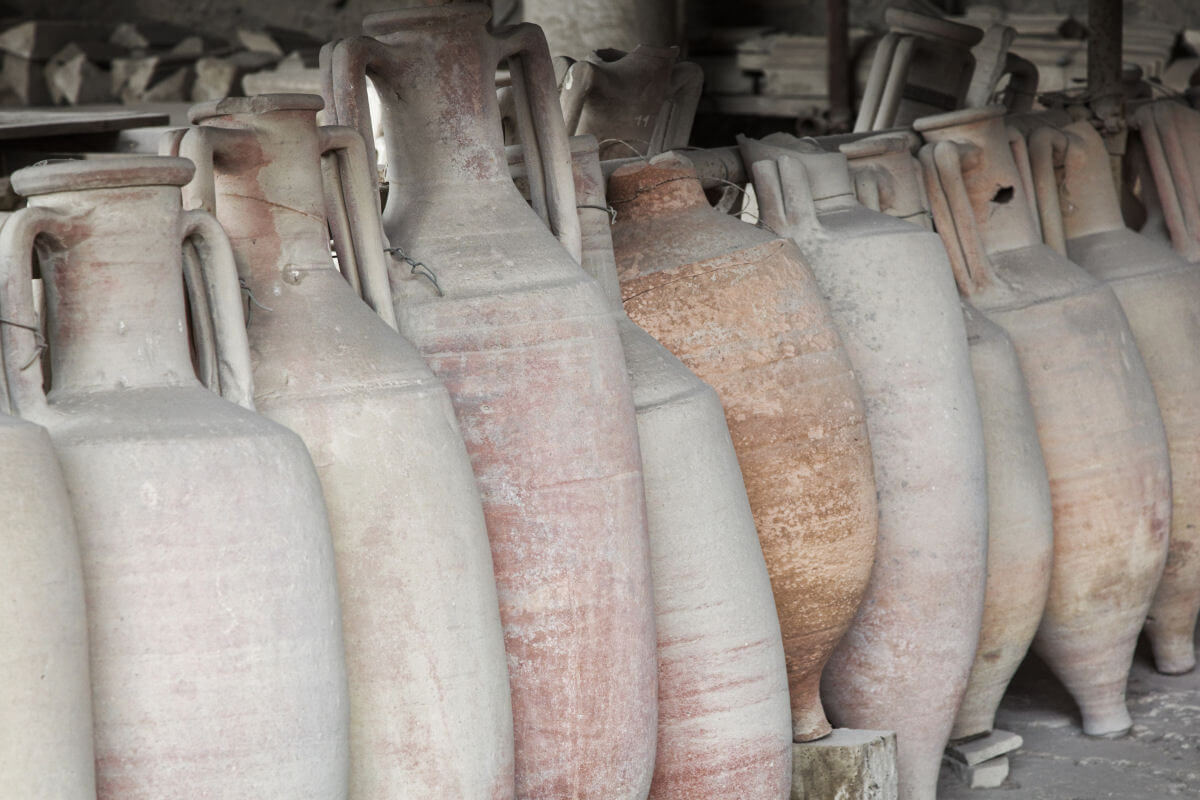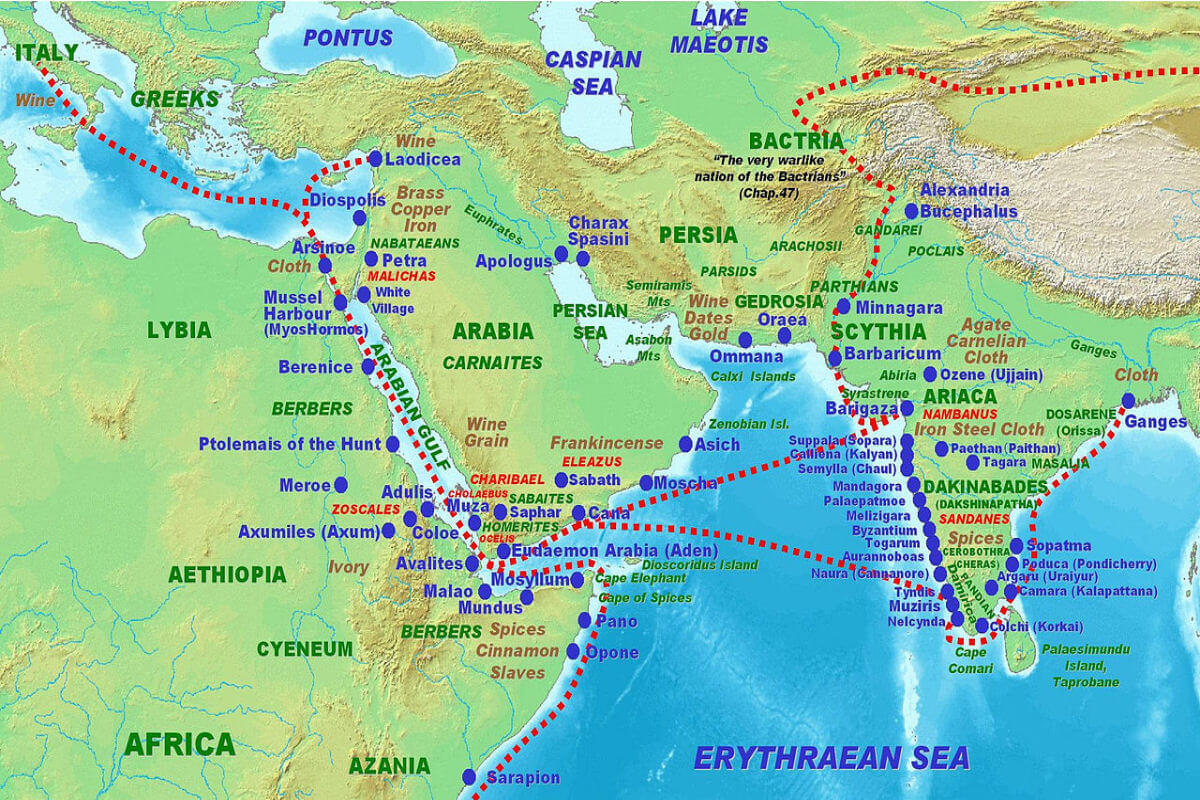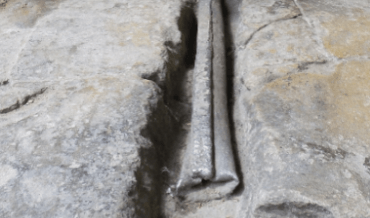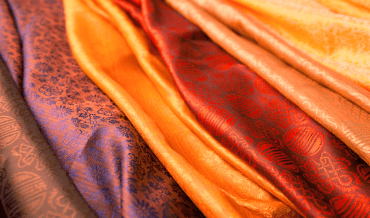Introduction to Roman Trade
Trade played a significant role in the Roman Empire, shaping both its economy and interactions with other civilizations. It involved the exchange of a wide range of goods - from essentials like food and clothing, to luxury items such as exotic spices and precious metals. The Roman Empire's trade network spanned vast regions, stretching from Africa and the Middle East to India and China.

Amphorae jars used for storing and transporting items such as food
Key trade routes within the empire included both overland routes and maritime paths along the Mediterranean and Black Seas. These pathways facilitated the movement of raw materials, finished products, and slaves from one part of the empire to another.
These regions not only provided valuable goods and materials, but also a plethora of mutually beneficial connections that enabled cultural and economic development. A few examples of imported goods include:
- Beef
- Corn
- Glassware
- Iron
- Lead
- Leather
- Marble
- Olive oil
- Perfumes
- Purple dye
- Silk
- Silver
- Spices
- Timber
- Wine
In exchange, provinces such as Britannia, for example, exported lead, woollen products, and tin.
The Roman economy relied heavily on taxes and conquest to maintain its vast territory and fund its military forces. Both indigenous and international traders contributed to the empire's revenue through the payment of taxes. Conquest, on the other hand, allowed the Roman Empire to acquire new provinces, resources, and laborers (mainly slaves), further fueling its economic expansion and trade.
Roman Trade Routes
Sea Routes
Roman trade thrived on the vast network of sea-based routes across the Mediterranean and Black Sea. Seaports played a significant role in connecting various regions, facilitating the movement of goods and passengers. In the Western Mediterranean, important ports included Ostia Antica and Puteoli, while in the Eastern Mediterranean, prominent trading hubs were Alexandria and Antioch.
One of the busiest maritime routes was the one connecting Italy to the Levantine coast, where crucial commodities like olive oil, wine, and grains were transported. Moreover, Roman ships frequently navigated the Red Sea corridor to reach trading partners in the Middle East and North Africa. The Black Sea region, on the other hand, facilitated trade with the Northern and Eastern provinces of the Roman Empire.
Land Routes
Along with sea routes, the Roman Empire was also known for its extensive network of overland trade routes as well. Roman roads were famed for their durability and efficiency, allowing for a steady flow of goods and people (as well as the legions) across the vast territories.
Key land trade routes connected major cities and provinces within the empire. For instance, the Via Appia was a significant artery that linked the city of Rome to Southern Italy. Meanwhile, the Via Egnatia was a road constructed by the Romans in the 2nd century BC. It crossed Illyricum, Macedonia, and Thracia, running through territory that is now part of present-day Albania, North Macedonia, Greece, and European Turkey as a continuation of the Via Appia.
It was a great east-west land route that led from Dyrrhachium (modern Durrës, Albania) through Macedonia to Thessalonica (present-day Thessaloníki, Greece) and on to Thrace.
Roman traders also ventured beyond the borders of the empire, interacting with eastern neighbors like Persia, and further afield with the Indian subcontinent through caravan routes and the Silk Road. These long-distance exchanges brought luxury items such as silk, spices, and precious stones to Rome, contributing to its wealth and influence on the global stage.

PHGCOM, CC BY-SA 4.0, via Wikimedia Commons
Roman trade in the subcontinent according to the Periplus Maris Erythraei, 1st century AD
Trading Commodities
Food and Raw Materials
The Roman Empire heavily relied on trade for obtaining various food items and raw materials for daily use and further production. Essential foodstuffs included olives, fish, meat, cereals, salt, and prepared foods like fish sauce (garum), olive oil, wine, and beer.
Some of the main imported materials were beef, corn, glassware, iron, lead, leather, marble, olive oil, perfumes, purple dye, silk, silver, spices, timber, and tin.
Luxury Goods
In addition to essential items, wealthy Roman citizens were also interested in luxury goods from different parts of the world. Products like silk were imported from China via camel caravans, while precious metals, jewels, high-quality textiles, and exotic spices were imported from Africa and the Near East.
Textiles
Textiles played a significant role in the Roman trade business, with particular importance given to materials like wool, silk, linen, and cotton. The textile industry flourished in various parts of the empire, with centers of production located in Egypt, Syria, and Gaul. These textiles were not only essential for clothing, but also for furnishing homes and creating sails for ships.
Metals
The Roman Empire was notable for trading various metals such as gold, silver, copper, brass, tin, iron, and lead. Metals were primarily used for manufacturing coins, weapons, construction materials, and creating decorative items and ornaments. The empire's extensive network of mines and metalworking workshops ensured a constant supply of these all-important materials.
Roman Marketplaces and Trading Cities
Roman marketplaces were centers of trade and commerce within the ancient Roman cities. These markets featured small shops and stalls where craftsmen sold their goods. Markets were essential to the Roman economy, as they facilitated the buying and selling of various commodities, both locally produced and imported.
Several important trading cities with busy markets existed in the Roman Empire. One notable city was Rome itself - the heart of the empire - which included the famous Trajan's Market. Other trading hubs included Alexandria in Egypt, Antioch in ancient Syria, and Carthage in North Africa. These cities were well-connected via sea and land routes, allowing for efficient movement of goods and people across the empire.
As already mentioned, a crucial component of Roman trade was its seaports. Ports played a vital role in the export and import of goods. The Roman Empire established a vast trade network across the Mediterranean, with ships regularly crossing from Italy to Carthage or Alexandria, for instance. Lighthouses, such as the famed Pharos Lighthouse in Alexandria, guided ships on their journeys, ensuring their safe arrival to harbor. River travel was also common, albeit slower.
Growth and Governmental Control
The growth of the Roman Empire was closely linked to its economic success, as the acquisition of new territories often led to the establishment of new trade routes and the inclusion of diverse resources and goods.
Conquests not only brought wealth in the form of plunder, but also provided an opportunity for the integration of various cultures and customs into the Roman civilization. This melding of cultures and access to new resources made Rome a center for knowledge, innovation, and creativity, fostering a thriving network of commerce and exchange.
A mix of state control and the free-market approach was employed to manage trade in the Roman world. This ensured that goods produced in one location could be exported far and wide, boosting the economy and ultimately, strengthening the empire.
The Roman government exercised control over some aspects of trade, such as taxation and the regulation of specific commodities, while also allowing for a competitive market and the private enterprise of merchants.
External Influence on Roman Trade, Culture and Daily Life
Roman trade was heavily influenced by its connection with various regions, and one of the major influences on Roman trade was its interaction with India. The Romans greatly valued Indian products such as spices, precious stones, and textiles. Along the Silk Road and the Indian Ocean trade routes, Roman traders exchanged their goods for these valuable Indian commodities.
Similarly, Roman trade with China focused on the exchange of Chinese silk, which was highly sought after by the Roman elite. This luxurious fabric was brought to Rome via established trade routes and other Asian regions.
Foreign traders from the aforementioned regions played a crucial role in introducing new products and ideas to the Roman world. These exchanges led to innovations in art, architecture, and technology that shaped Roman society. The diversity of products imported from different countries fostered a competitive trading environment within the empire, leading to economic growth and widespread prosperity.
Trade Intermediaries
In the Roman world, trade intermediaries were necessary for facilitating the exchange of goods across vast distances. They ensured the smooth flow of commerce between various regions and took on the responsibility of transporting goods, as well as acting as middlemen in the trade process.
Merchants were key figures in the Roman trade system. They often specialized in certain trade goods, such as textiles, spices, metals, or other commodities that were in high demand across the empire. As experts in their chosen fields, merchants were able to identify the best items, negotiate prices, and manage the risks associated with transportation, storage, and distribution. Their expertise and connections allowed them to respond quickly to shifts in supply and demand.
Middlemen also played a significant role in the Roman trade system. They acted as intermediaries between producers and consumers, ensuring that goods were transported from their point of origin to their final destination. Middlemen were often responsible for organizing the logistics of trade, such as arranging the shipping or land transportation of goods and managing the warehouses where these goods were temporarily stored. By acting as a bridge between different stages of the supply chain, middlemen added value to the trade process and contributed to the overall efficiency of the Roman market.
Money and Coinage
Currency was an essential part of the Roman trade system, creating a unified market throughout the empire. The Roman currency system operated on a mixture of coinage and bullion, and the predominant currency for many centuries was the denarius, a silver coin. As the size of the empire expanded, so did the complexity of the currency system, leading to the development of regional coinages.
Banking services were also available in ancient Rome, primarily aimed at merchants engaged in trade. Bankers known as argentarii provided services such as deposits, loans, and currency exchange for clients. Argentarii were private Roman bankers who appeared in the 3rd century BC. They were money changers who exchanged foreign currency for Roman coins, and they also minted and tested currency.
They were independent from the state and belonged to a guild that accepted only a limited number of new members. They conducted their business around the Forum, near the Temple of Castor and Pollux. Just like today, bad lending decisions could result in bankruptcy for the bankers!
This financial infrastructure contributed to the efficient movement of goods and allowed for the accumulation of wealth in different regions of the empire.
Trade Evolution and Exchange Mechanism
Trade in the Roman world underwent significant evolution over time, influenced by the expansion of the empire, technological advancements, and shifting socioeconomic factors. This trade was characterized by regional, inter-regional, and international transactions, facilitated through a mix of state control and free market approaches.
In the very early days during the founding of the Roman civilization, the exchange mechanism in Roman trade was initially based on bartering, with goods and services directly exchanged between trading parties.
As the Roman Empire grew, more sophisticated forms of exchanges developed, involving commonly-agreed commodity currencies such as bronze or copper ingots, or even cowrie shells. These currencies enabled individuals and merchants to trade goods and services in a more fluid and efficient manner.
Competition played a significant role in the Roman trade system. With numerous merchants and traders vying for business in the bustling empire, a competitive market emerged. This competition proved beneficial for the economy as it led to increased production, variety of goods, and an overall improvement in the quality of products and services, as well as keeping prices at a reasonable and affordable level... most of the time.
Explore More About Individual Trade Goods and Raw Materials
Within this section you will find a list of goods that were used in trade. Some were rare, some expensive, and some used every day, however each of them were an integral part of the Roman economy.
Please click on a title below to find out more information about that particular trade good.











